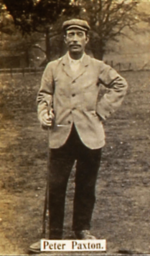|
Peter Paxton
Peter Paxton (20 October 1857 – 3 July 1929) was a Scottish professional golfer who played in the late 19th century. Paxton had three top-10 finishes in the Open Championship. He took second place in the 1880 Open Championship five shots behind winner Bob Ferguson. Paxton was an expert club and ball maker. His golf ball inventions included the Bramble and Sirdar models, the former being the ball of choice for Harry Vardon at one time.[1] Paxton was also the designer of a number of golf courses, with Coventry Golf Club (Coventry, England) and East Berkshire Golf Club (East Berkshire, England) being among those designs.[2] Early lifePaxton was born in Musselburgh, Scotland, on 20 October 1857. Peter was born to James Paxton, a cab driver, and his wife Elizabeth Sharp.[1] In September 1881 he married Sarah Hobley at Upton-upon-Severn, Worcestershire, England. They had two children, George and Elizabeth.[3] His older brother George was also a professional golfer. Golf career1880 Open ChampionshipThe 1880 Open Championship was held 9 April at Musselburgh Links, Musselburgh, East Lothian, Scotland. Bob Ferguson won the Championship by five strokes from runner-up Paxton who carded rounds of 81-86=167.[4] 1883 Open ChampionshipIn the 1883 Open Championship, again held at Musselburgh Links, he was tied for tenth place.[4] Bob Ferguson dominated play from 1880-82 by winning three Open Championships in a row. Paxton shots rounds of 46-39-39-43=167.[4] 1885 Open ChampionshipThe 1885 Open Championship was the 25th Open Championship, held 3 October at the Old Course at St Andrews, Fife, Scotland. Bob Martin won the Championship for the second time, by one stroke from Archie Simpson. Paxton fired rounds of 85-91=176, finishing in eighth place, and won £1 in prize money.[4] Match vs. Albert Tingey, Sr.Paxton met Albert Tingey, Sr. in a memorable match on 27 October 1900 on a windy and wet day at Tooting Bec Golf Club in south London. Paxton, playing on his home links, was likely the betting favorite, although his results going in were not equal with Tingey who in October 1899 had halved against Harry Vardon at Watford[5] and had been playing better golf in the short term. Heavy rain the day before had soaked the course making approach shots and putting difficult. Playing in stiff winds, the first 27 holes were stubbornly contested to a draw, but Tingey pulled away in the end winning 4 and 3.[6] Club makerPaxton was an expert club and ball maker, his clubs being highly desirable in his day and beyond. Not unlike other golfers of his era, he began as a caddie at Musselburgh. He apprenticed as a club maker under David Park, the brother of Willie Park, Sr. In addition to the tutelage he received under David Park, he also picked up a few useful skills when he later apprenticed under Tom Hood. He took a job as the professional from his brother John at Malvern’s Worcestershire Club and was later posted at Royal Eastbourne.[7] Paxton exhibited considerable inventiveness when in 1892 he created a machine that would produce several thousand gutta-percha golf balls weekly. He received patents on a type of grip and also for square socketed clubs. Some of his clubs were made from an unusual type of hardwood that he called “sylviac”, but it could possibly have been itauba. He left Royal Eastbourne in 1893—with several skilled club makers joining him—and took up a new post at Tooting Bec. By this time, he had gained the royal patronage of the Duke and Duchess of York and therefore placed a crown mark on the clubs he made.[7] Balls, clubs and other items made by Paxton were displayed on the golf stall at the Sports and Pastimes Exhibition at the Crystal Palace in 1893.[8] Later life and deathPaxton was professional at Old Colwyn Golf Club from 1910[9][10] before moving to Oakwood Park Hotel, Conway.[1][11] Paxton died in Romford, Essex, on 3 July 1929.[12] Results in The Open Championship
Note: Paxton played only in The Open Championship. DNP = Did not play References
|
||||||||||||||||||||||||||||||||||||||||||||||||||||||||||||||||||||||||||||||||||||||||||||
